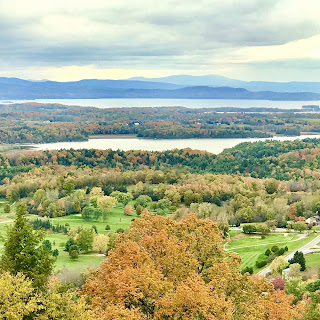Sunset from the Poplar Hill. A warm, moist afternoon. The clouds lift in the west, — indeed the horizon is now clear all around.
The boys are gathering walnuts. Their leaves are a yellowish brown.
8 p.m.— To Cliffs.
After whatever revolutions in my moods and experiences, when I come forth at evening, as if from years of confinement to the house, I see the few stars which make the constellation of the Lesser Bear in the same relative position, - the everlasting geometry of the stars.
The moon beginning to wane. It is a quite warm but moist night. The dew in the withered grass reflects the moonlight like glow-worms.
That star which accompanies the moon will not be her companion tomorrow.
The forest has lost so many leaves that its floor and paths are much more checkered with light. I hear no sound but the rustling of the withered leaves, and, on the wooded hilltops, the roar of the wind. Each tree resounds all night, though some have but a few leaves left to flutter and hum.
Four months of the green leaf make all our summer, if I reckon from June 1st to October 1st, the growing season, and methinks there are about four months when the ground is white with snow. That would leave two months for spring and two for autumn. October the month of ripe or painted leaves; November the month of withered leaves and bare twigs and limbs.
H. D. Thoreau, Journal, October 28, 1852
Suddenly the light of the setting sun yellows and warms all the landscape. See October 28, 1857 ("All at once a low-slanted glade of sunlight from one of heaven’s west windows behind me fell on the bare gray maples, lighting them up with an incredibly intense and pure white light;"); See also October 21 1857 ("I see, this cool and grayish evening, that peculiar yellow light in the east, from the sun at little before its setting. It has just come out beneath a great cold slate-colored cloud that occupies most of the western sky, as smaller ones the eastern, and now its rays, slanting over the hill in whose shadow I float, fall on the eastern trees and hills with a thin, yellow light"); October 22, 1852 ("We have to-night a bright warm sunset after a cool gray afternoon, lighting up the green pines at the northeast end of the pond"); October 22, 1854 ("t was a beautiful evening, and a clear amber sunset lit up all the eastern shores"); October 27, 1858 ("We have a cool, white sunset, Novemberish, and no redness to warm our thoughts."); October 31, 1858 ("Looking off just before sunset, when all other trees visible for miles around are reddish or green, I distinguish my new acquaintance by its yellow color"); and also August 31, 1852 ("The evening of the year is colored like the sunset."); November 14, 1853 ("October is the month of painted leaves, . . .it is the sunset month of the year, when the earth is painted like the sunset sky. . . .This light fades into the clear, white, leafless twilight of November, and what ever more glowing sunset or Indian summer we have then is the afterglow of the year.”)
The sun setting red
in haze at the same time as
the full moon rises.
October 8, 1851
The mountains distinct –
the sunset sky white and cold
now as I come home.
A bright warm sunset
after a gray afternoon
lights up every leaf.
October 22, 1852
October the month of ripe or painted leaves. See August 31, 1852 ("The evening of the year is colored like the sunset.”); November 14, 1853 (“October . . . is the sunset month of the year, when the earth is painted like the sunset sky.”)
The boys are gathering walnuts. See October 24, 1852 ("I see, far over the river, boys gathering walnuts."); October 24, 1857 ("I hear the dull thump of heavy stones against the trees from far through the rustling wood, where boys are ranging for nuts. ")
https://tinyurl.com/HDT521028













